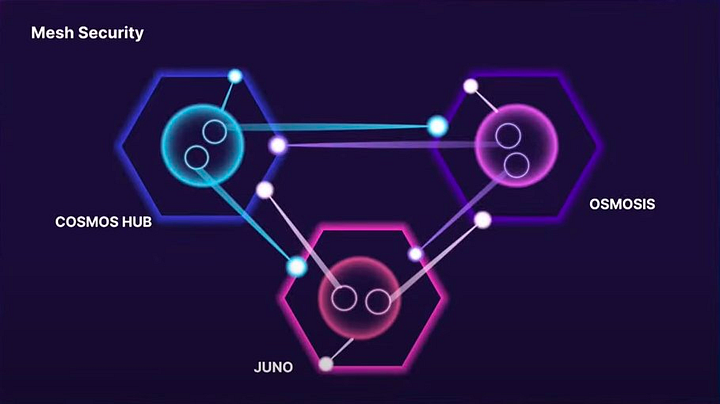Application Chain Innovation: Can Mesh Security Revitalize the Osmosis Ecosystem?
Author: Bing Ventures
In previous articles, we explored how application chains can grant developers technical sovereignty, enabling them to unleash creativity. By experimenting with different consensus models, custom node requirements, state models, and other innovative features, developers can explore and experiment with the technical solutions that best suit their applications. The sovereignty of independent blockchains allows applications to prioritize the value of their public chains and make decisions based on the most meaningful trade-offs. This sovereignty enables application chains to allow communities to take control of their own destinies.
However, we have also concluded that application chains are not a perfect solution for all projects, but rather a subjective trade-off. Some critics have pointed out issues with the application chain approach regarding synchronizing composability and liquidity fragmentation. Nevertheless, just as liquidity on general L1s tends to concentrate in a few popular applications, a similar phenomenon will occur in the application chain ecosystem, where various DeFi functionalities will concentrate in the core products of a few high-liquidity application chains, thus making liquidity fragmentation less of a problem. This is being evidenced in the development of Osmosis.
Advantages of Concentrated Liquidity
DeFi projects face many challenges in user experience, such as complex operational processes, high transaction fees, network congestion, and low liquidity. As an application chain DEX and emerging liquidity hub within the Cosmos ecosystem, Osmosis is attempting to leverage the advantages of application chains to address these issues. Osmosis allows users to create liquidity pools with unique and variable parameters, experimenting with different types of bonding curves, multi-weight asset pools, and more. Additionally, Osmosis has introduced innovative features such as super liquid staking, incentivizing users to participate in the chain's security by using LP tokens that include $OSMO, thereby returning more value to the community.
We have previously articulated a viewpoint in multiple articles: in Cosmos, liquidity will determine security. Osmosis is a project that launched at the early stages of IBC, when the liquidity of the entire ecosystem was very limited. To address this issue, Osmosis introduced Balancer-style liquidity pools, attracting a significant amount of liquidity into Cosmos through incentives. However, since the funds were dispersed across various pools, much of the liquidity was not fully utilized.
The concept of concentrated liquidity emerged, allowing liquidity providers to choose to provide liquidity within a specific price range. This means that concentrated liquidity will make users more strategic when providing liquidity. At the same time, Osmosis can handle the same transaction volume with less liquidity, thereby increasing efficiency, which has improved by approximately 100 times.
The upcoming Supercharged Pools incentive model in Osmosis further optimizes the use of liquidity pools. This model allows users to claim rewards on their own without having to wait for a specific time period. Additionally, there is no need to bond LP tokens when entering Supercharged liquidity pools. However, if users wish to participate in Superfluid Staking, there are still relevant bonding requirements.
The Emergence of Mesh Security
Another significant innovation of Osmosis, which complements concentrated liquidity, is Mesh Security. Mesh Security is an innovative cross-chain security model designed to enhance the security of the Cosmos ecosystem. The core idea of this model is to increase security through the combination of cross-chain staked assets, addressing the security vulnerabilities and validator collateral takeover issues present in traditional cross-chain models.
First, in traditional cross-chain security models, security flows in one direction. A validator set fully validates another chain, which, while improving efficiency, leads to a lack of sovereignty in the ecosystem. Another model allows subsets of the validator set to choose to validate on a single chain, improving scalability but failing to fully utilize governance, leaving the ecosystem still lacking sovereignty. In contrast, under Osmosis's Mesh Security model, security can flow in both directions. Ecosystems can have their own validator sets, maintaining sovereignty while providing mutual security between two chains.
The Mesh Security model allows staked tokens on one chain to be re-staked to validators of partner chains, enabling Cosmos chains to pool validators' stakes together to resist security attacks, thereby increasing the security of individual Cosmos chains. In summary, Mesh Security can benefit from the protection of ATOM stakers while enhancing the security of Cosmos through OSMO staking.
We anticipate that the Mesh Security model will bring long-term benefits to the Osmosis ecosystem. One of the important roles of the Mesh Security model is to prevent validator misconduct and the resulting slashing of tokens, thus protecting the security of transactions. Additionally, the introduction of this security model helps to guard against MEV-related attacks, ensuring fairness in the transaction process. Mesh Security, combined with concentrated liquidity that can improve transaction efficiency, will provide a more reliable and secure trading environment for users and ecosystem participants, promoting the sustainable development of Cosmos.

Source: Osmosis
The Innovative Path of Osmosis and DeFi Application Chains
Osmosis is striving to achieve a top-tier centralized exchange user experience, including integrating leveraged trading and lending into its core products, and collaborating with Mars Protocol to directly incorporate lending into the Osmosis trading engine. Furthermore, Osmosis has explored various innovative methods for handling MEV on its DEX, such as threshold encryption, fee differentiation, Flashbots-like functionalities, and in-protocol arbitrageurs running at the start of each block.
As a pioneer of DeFi application chains, Osmosis fully leverages the powerful developer tools and asynchronous composability infrastructure of the Cosmos ecosystem, promising to have a profound impact on the entire DeFi ecosystem.
Regarding the Mesh Security model, despite its many benefits, it also presents some challenges and risks, including the existence of centralized models and the complexities of cross-chain collaboration and governance. Therefore, future developments need to carefully consider how to address these issues to ensure the preservation of decentralization and the balance of interests among all parties.
In handling MEV, Osmosis has demonstrated its innovative capabilities and advantages, particularly in threshold encryption. This provides a potential solution to resist MEV attacks and gives Osmosis a competitive edge in the Cosmos ecosystem compared to Ethereum.
The development of Liquid Staking will also flourish on Osmosis. Cosmos offers higher staking rates and moderate unlocking periods, providing users with a more flexible liquidity management approach. Further innovations will position Osmosis as a platform offering flexible lending yields and leveraged mining opportunities, enhancing asset efficiency and staking rates.
Finally, we are optimistic about the innovation of stablecoins, which may be the most important direction for Osmosis's future development. By introducing more diversified and innovative stablecoins, Osmosis will solidify its position as the DeFi liquidity hub on Cosmos and promote the further development of liquidity markets. This will provide users with more trading and investment opportunities, catering to the needs of different users.











